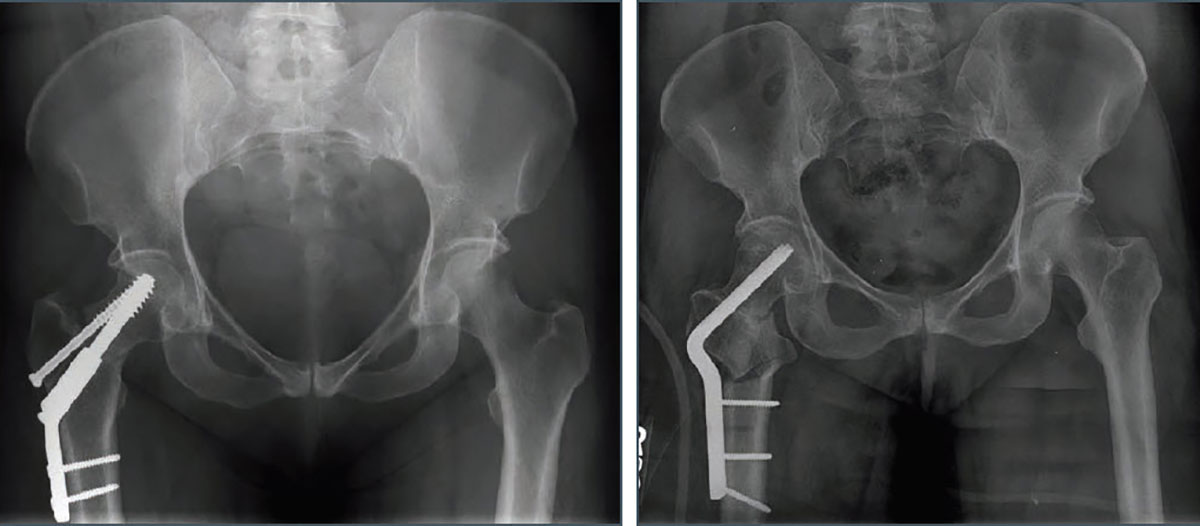Digital pre-operative planning for challenging procedures can increase the chances of a successful and more predictable outcome, as was the case for a female runner who suffered a displaced right femoral neck stress fracture that failed to heal with conservative treatment. To improve her quality of life, the orthopaedic trauma surgeon and assistant-professor of orthopaedic surgery Dr. Samir Mehta, MD used Materialise OrthoView to pre-operatively plan a valgus osteotomy for femoral neck fracture non-union.
The patient, a 43-year-old female runner, was initially treated at an outside hospital with percutaneous reduction and internal fixation. But six months after the operation, she was experiencing increasing pain and a limited range of motion. Physical examination and x-ray images indicated asymmetric hip joints, a case of coxa vara (resulting in the affected side being shorter than the non-affected side), and a femoral neck non-union on the right.
At that point, two surgical procedures were possible: a hip arthroplasty or a proximal femoral osteotomy. While a hip replacement would have been a fairly straightforward procedure allowing for immediate weight-bearing, it would – in this case – have resulted in suboptimal long-term results, given the patient’s desire to return to running. By contrast, a femoral osteotomy, despite posing significant technical challenges, would resolve the leg discrepancy caused by the hip being in varus. Furthermore, it would allow the non-union to heal and the native femoral head to be maintained. Once healed, the patient would not experience any limitations or restrictions in her activities and could go back to regular running – a wish she had made explicitly.
Planning procedures pre-operatively
Weighing all the options, orthopaedic trauma surgeon Dr. Samir Mehta, MD decided on a val¬gus-producing intertrochanteric osteotomy. To prepare for this technically challenging surgery, he needed to create detailed pre-operative plans. Dedicated AP and lateral x-ray images of the hip were obtained, and included a calibration marker, which allowed for measurement of image magnification and image scaling in the Materialise OrthoView templating software.

Dr Mehta was able to determine the neck-shaft angle and the leg-length discrepancy of the right leg versus the left leg using Materialise OrthoView. To have an idea of what the affected side should look like after the osteotomy, the non-affected side was templated as well. Next, the angle of the non-union was determined relative to the injured and non-injured femoral neck. Digital pre-operative planning plays a significant role in visualizing how to optimize femoral neck non-union healing by making it perpendicular to the joint reactive forces along the femoral neck.
In addition to creating detailed plans, Materialise OrthoView enables its users to be better prepared when entering the OR and, consequently, reduces the number of intra-operative decisions significantly. In this case, the intertrochanteric osteotomy was performed digitally beforehand. After a final check of the new neck-shaft angle, the hardware used to perform the valgus osteotomy was measured to order the appropriate equipment, including a correct angle blade plate with an appropriately sized blade.
Always there for surgeons and patients
Once all the necessary pre-operative plans had been created digitally, Dr. Samir Mehta, MD was able to perform the valgus osteotomy on the patient. Post-operative examinations showed a now optimal position of the femoral neck and a correction of the 14-degree neck shaft angle. Treating the coxa vara also resolved the leg-length discrepancy.
This case clearly demonstrates the benefits of digital pre-operative planning for challenging surgical procedures and how it can increase your chances of achieving optimal results. It enables surgeons to formulate a plan, provides intra-operative checks, and facilitates post-operative assessment of the outcome as compared to the pre-operative plan. A significant benefit to both orthopaedic experts and patients.
Plan. Prepare. Succeed.
Materialise OrthoView facilitates digital planning and templating for joint arthroplasty and revisions, trauma, limb deformity correction, osteotomy, and spinal assessment. Hospitals and orthopaedic clinics worldwide choose our software to complete their film-free radiology targets. To find out more about how you too can benefit from Materialise OrthoView, we invite you to check out or website or contact us.
